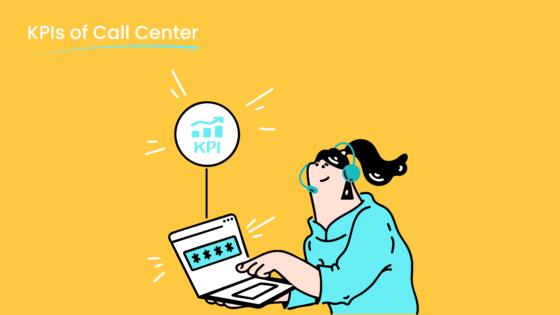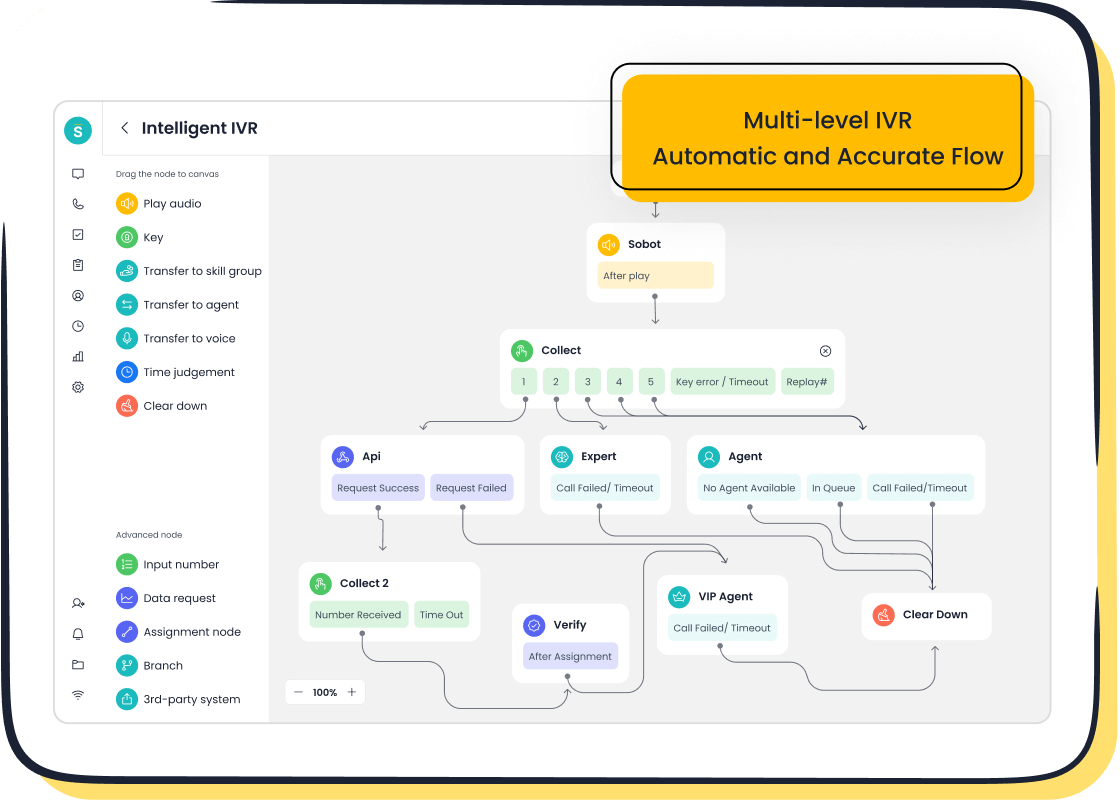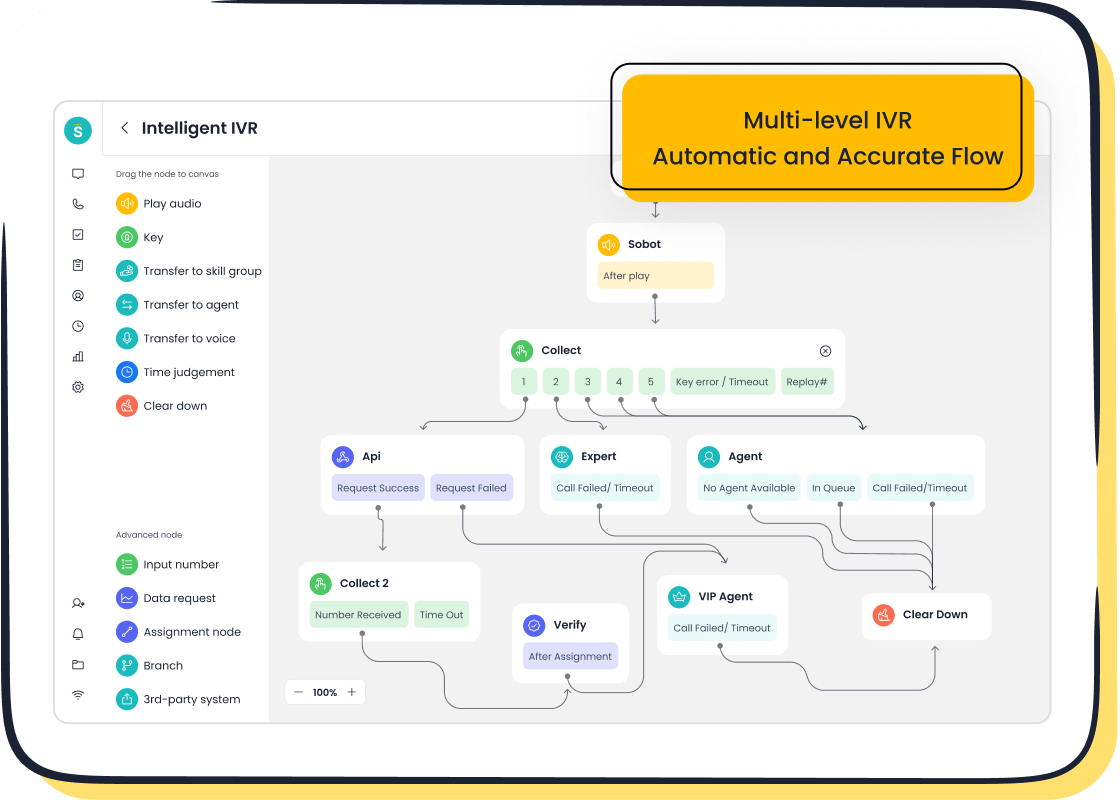Real-Time vs Post-Call Agent Monitoring Which Is Better?

You want to improve call center agent monitoring. The best strategy is not choosing one method. You should combine both real-time monitoring and post-call monitoring. Real-time monitoring provides immediate support to boost agent performance. Post-call monitoring offers deep insights for long-term skill development and better agent performance. This dual approach helps you improve agent performance and achieve higher customer satisfaction.
Tip: A unified platform like the Sobot call center, powered by Sobot AI, helps you manage both monitoring types seamlessly to enhance your customer service.
Understanding Call Center Agent Monitoring
Effective call center agent monitoring is the foundation of a strong quality management program. You need to understand the two primary methods to build a successful strategy. Both approaches offer unique benefits for your call center quality monitoring efforts.
What Is Real-Time Monitoring?
Real-time monitoring allows you to observe and assist agents during live customer interactions. You can listen to calls as they happen. This method is perfect for providing immediate support. For example, you can send a private message to an agent with the right answer. This proactive approach helps resolve issues on the spot. It is a key tool for immediate performance correction and on-the-job training. The analytics from this process provide instant feedback.
What Is Post-Call Monitoring?
Post-call monitoring involves reviewing interactions after they have ended. You analyze call recordings, transcripts, and associated data. This method gives you a complete picture of agent performance without the pressure of a live call. You can use detailed analytics to identify patterns and skill gaps. Post-call monitoring is essential for in-depth coaching, strategic planning, and improving your overall call center quality monitoring process. The analytics help you understand long-term trends.
Tip: Use post-call analytics to build a library of best-practice call examples. You can use these examples in your training sessions to show agents what success looks like.
Key Differences at a Glance
Understanding the core differences helps you use each method effectively. Your call center agent monitoring strategy should leverage the strengths of both. The right analytics from each method will guide your decisions. You can use real-time analytics for quick fixes and post-call analytics for deep insights. This combined approach uses powerful analytics to drive improvement.
| Feature | Real-Time Monitoring | Post-Call Monitoring |
|---|---|---|
| Timing | During the live call | After the call is complete |
| Primary Goal | Immediate intervention and support | In-depth analysis and coaching |
| Focus | On-the-spot problem solving | Identifying trends and skill gaps |
| Analytics Use | Instant performance analytics | Historical and trend analytics |
The Power of Real-Time Monitoring
Real-time monitoring transforms your quality assurance from a reactive process into a proactive strategy. You can directly influence the outcome of customer interactions as they happen. This method empowers you to improve agent performance and elevate the customer experience in the moment.
Instant Issue Resolution
You can solve customer problems on the first call with live monitoring. When an agent struggles, you can intervene immediately. This prevents call escalations and repeat contacts. Quick resolutions build stronger emotional connections with customers and boost satisfaction.
A 1% increase in first-call resolution can lead to a 1% rise in customer satisfaction. This improved quality of service makes customers more likely to stay with your brand.
Instant support during customer interactions also helps:
- Reduce customer churn by resolving issues at the first point of contact.
- Increase customer lifetime value through positive support experiences.
- Improve your Customer Effort Score (CES) by making it easier for customers to get help.
On-the-Job Agent Training
Live monitoring is a powerful tool for on-the-job training. You can use whisper coaching to guide agents during difficult customer interactions without the customer knowing. This real-time feedback helps new hires build confidence and skills quickly. For example, one team reduced new agent ramp-up time by 50% in just one week using whisper coaching. This approach improves agent performance and call quality from day one.
Ensuring Critical Compliance
Your business must follow strict industry regulations. Real-time monitoring helps you enforce compliance standards like PCI DSS and HIPAA during live calls. AI-powered systems can monitor 100% of customer interactions for potential violations. You can receive instant alerts if an agent says a non-compliant phrase or forgets a required disclosure. This immediate insight allows you to correct issues on the spot, protecting your business from costly fines and maintaining customer trust. Your quality assurance process becomes a powerful compliance tool.
Leveraging Real-Time Analytics
Real-time analytics give you immediate insights into your call center operations. Dashboards with live data help you manage your team effectively. You can use real-time analytics to see call volume spikes and adjust staffing instantly. These analytics also help you track agent performance and adherence to schedules. By making key metrics visible, real-time analytics empower you to make proactive decisions. You can use the immediate insights from real-time analytics to optimize your customer service. The analytics provide a clear view of your operations. Real-time analytics are essential for modern customer service management. The analytics offer powerful immediate insights. You can use real-time analytics to improve your team's efficiency. The analytics help you understand performance. Real-time analytics provide the data you need. The analytics support better decisions. Real-time analytics are key to great agent performance.

The Strategic Value of Post-Call Monitoring
While real-time monitoring handles immediate needs, post-call monitoring is your tool for long-term strategic growth. You can use detailed data analysis to drive significant performance improvement. This method allows you to step back and see the bigger picture, turning past customer interactions into future successes.
In-Depth Performance Reviews
You can conduct fair and comprehensive performance analysis with call recordings. This process provides the foundation for effective post-call coaching. To ensure fairness, you should establish clear review criteria.
Focus on key areas such as:
- Effective communication and empathy
- Adherence to company protocols
- Problem-solving abilities
- Customer engagement during the call
Consistent reviews help you deliver targeted feedback. This transforms your coaching sessions into powerful opportunities for growth. Effective post-call coaching is built on solid data. This type of performance coaching improves agent performance.
Gaining Insights with Post-Call Analytics
Post-call analytics give you a treasure trove of information. You can use analytics to measure key metrics like Customer Satisfaction (CSAT) and First Call Resolution (FCR). Advanced post-call analytics use AI and Natural Language Processing (NLP) to scan customer interactions. These analytics identify keywords and gauge customer sentiment. This data analysis helps you understand the emotional tone of calls. You can track these trends over time to see how your changes impact the customer experience. The right post-call analytics and performance coaching will elevate your team. Using post-call analytics is key to better post-call coaching.
Building a Best-Practice Library
You can use post-call analytics to create a library of excellent call examples. Identify recordings where agents masterfully handle difficult situations or create happy customers. You can use these model customer interactions in your training programs. This library shows agents exactly what success looks like. It provides a clear roadmap for improving agent performance. This is a practical application of post-call coaching. Good post-call analytics make finding these calls easy. The analytics support better post-call coaching.
Identifying Root Causes and Trends
Post-call analytics help you uncover the root causes of customer issues. By analyzing conversation patterns and spotting keywords across many customer interactions, you can identify recurring problems with products or services.
This approach allows you to take proactive steps. You fix underlying issues instead of just handling symptoms. This strategic use of analytics and post-call coaching leads to lasting performance improvement. Your post-call analytics and post-call coaching efforts become a powerful combination. The analytics provide the insights for great post-call coaching.
Unifying Monitoring with Sobot's Voice Call Center


You need a platform that supports both monitoring methods without creating extra work. Sobot's Voice Call Center is designed to unify your quality program seamlessly. It combines all tools into a single Unified Workspace, giving you access to real-time monitoring and analysis features in one place. This integration allows you to manage in-the-moment support and long-term strategy from a central hub. The powerful real-time analytics and post-call analytics provide the data you need.
Enabling Real-Time Support
You can provide immediate assistance to agents during live customer interactions. Sobot's platform, with its stable 99.99% uptime, enables effective live monitoring. You can listen to calls silently or use whisper coaching to guide an agent privately. This on-the-spot support improves agent performance and enhances customer service. The real-time analytics give you instant visibility into call queues and agent activity. You use real-time analytics to make quick staffing decisions. These analytics help you manage your team proactively. The real-time analytics offer a clear view of operations. The real-time analytics support better decisions. The real-time analytics are key to great agent performance. The analytics from real-time analytics provide immediate insights. The real-time analytics improve your customer service. The analytics from real-time analytics are powerful.
Facilitating In-Depth Reviews
For strategic improvements, you need accurate records of past customer interactions. Sobot’s Recording & transcripting feature creates a detailed, searchable text version of every call. Reviewing transcripts is much faster than listening to audio recordings. This makes your review process more efficient and objective. You use post-call analytics to scan these transcripts for keywords, trends, and customer sentiment. These post-call analytics are vital for effective coaching. The post-call analytics help you understand the customer experience. The analytics from post-call analytics reveal skill gaps. The post-call analytics drive strategic changes. The analytics from post-call analytics build a foundation for training. The post-call analytics improve agent performance. The analytics from post-call analytics are essential. The analytics from post-call analytics guide your strategy.
A Real-World Success Story
Combining both monitoring types on a single platform delivers proven results.
Samsung used Sobot's all-in-one contact center solution to unify its operations. By leveraging tools for both
live monitoringand in-depth analysis ofcustomer interactions, they achieved a 97%customer satisfactionrate and a 30% increase in agent efficiency.
This success shows how an integrated approach, powered by strong analytics and post-call analytics, directly boosts customer satisfaction and operational excellence. The analytics provided the necessary insights.
A Blended Strategy for Call Center Quality Monitoring
You can create a powerful synergy by combining real-time and post-call monitoring. This blended approach gives you a complete framework for call center quality monitoring. You can structure your efforts across daily, weekly, and monthly cycles. This ensures you address immediate needs while driving long-term strategic improvements in quality management.
Daily Support and Intervention
Your daily focus should be on providing immediate support through real-time monitoring. This proactive approach helps you manage the quality of live interactions and support your agents when they need it most. Your supervisors can use real-time analytics to make instant, data-driven decisions.
Your daily tasks should include:
- Tracking Live Calls: You can monitor ongoing conversations to ensure agents follow compliance rules and steer discussions in a positive direction.
- Monitoring Customer Sentiment: Live sentiment tracking gives you immediate insights. You can use real-time analytics to spot customer dissatisfaction and intervene before a situation escalates.
- Providing In-the-Moment Coaching: Supervisors can use real-time analytics to see when an agent is struggling. This allows them to offer immediate feedback and guidance to improve skills on the spot.
You can set up alerts for specific triggers. For example, you can get a notification when a high-value customer calls or when an agent uses non-compliant language. This allows you to provide timely support and prevent critical errors, strengthening your quality assurance process.
Weekly Structured Coaching
You should dedicate time each week for structured post-call coaching. These sessions use post-call analytics to provide agents with personalized, data-backed feedback. This is where you turn insights from your call center agent monitoring into actionable performance coaching. You can use post-call analytics to identify specific calls for review. Effective post-call coaching is built on a foundation of objective analytics.
A typical weekly coaching session agenda might look like this:
- Opening (5 min): Start with a personal check-in and review the agent's goals.
- Review (10 min): Discuss progress from the last session using data from post-call analytics.
- Self-Assessment (10 min): Ask the agent to reflect on their own performance.
- Obstacle Analysis (10 min): Use post-call analytics to pinpoint challenges and brainstorm solutions together.
- Action Plan (15 min): Set new, data-driven goals for the upcoming week. Your post-call coaching should always end with clear next steps.
You can use post-call analytics to personalize these plans. For instance, if post-call analytics show an agent struggles with empathy, you can focus the post-call coaching on that specific behavior. This targeted performance coaching makes your quality management efforts more effective. The detailed analytics provide the proof needed for impactful post-call coaching.
Monthly Strategic Reviews
Your monthly reviews shift the focus from individual performance to the big picture. You use aggregated post-call analytics to evaluate your entire call center quality monitoring program. This high-level data analysis helps you identify broad trends and make strategic decisions. This is a critical part of your quality management.
During these reviews, you should assess key performance indicators (KPIs) to measure the success of your quality assurance program. Focus on metrics like:
- Net Promoter Score (NPS)
- First Call Resolution (FCR)
- Average Handle Time (AHT)
- Customer Satisfaction (CSAT)
To build a strong foundation for your call center quality monitoring, you must first define clear standards. Break down what a "good call" means into specific behaviors and goals. This gives your analytics a clear benchmark for success.
The insights from these reviews inform larger changes. If your post-call analytics reveal a common customer complaint, you can update your agent training or fix an underlying product issue. This strategic use of analytics and post-call coaching improves the entire customer experience. The analytics from your call center agent monitoring become a driver for business-wide improvements.
Integrating Technology for a Seamless Workflow
A successful blended strategy depends on technology that brings everything together. You need a platform that allows data to flow seamlessly between your real-time and post-call activities. Integrating your CRM with your call center software is essential.
This integration creates a unified workflow where:
- Call routing is smarter. You can use CRM data to direct customers to the most qualified agent, improving first-call resolution.
- Agents have full context. APIs ensure agents see a customer's full history across all channels, so they can solve problems without asking repetitive questions.
- Reporting is simplified. A unified system connects your real-time analytics and post-call analytics. This gives you a single source of truth for all your analytics, making it easier to spot trends and make better decisions.
A platform like Sobot's Voice Call Center provides this seamless integration. It connects your monitoring tools, analytics, and agent workspace. This ensures your daily, weekly, and monthly quality efforts work together as one cohesive system for excellent post-call coaching.
You get the best results by blending real-time monitoring with post-call monitoring. This dual strategy improves agent performance. Real-time monitoring handles immediate quality control for better agent performance. Post-call monitoring uses post-call analytics to drive long-term strategic improvements. The analytics from post-call analytics boost agent performance and customer satisfaction. A unified strategy, supported by a platform like Sobot with powerful analytics, is the definitive answer. It improves agent performance, increases customer satisfaction, and boosts efficiency. The analytics from post-call analytics provide the insights you need. These analytics improve agent performance and customer satisfaction.
FAQ
Which monitoring method is better for my call center?
You should not choose one over the other. The best strategy combines both. You use real-time monitoring for immediate support. You use post-call monitoring for long-term analysis. This dual approach is best for improving agent performance.
How does real-time monitoring help new agents?
Real-time monitoring provides on-the-job training. You can use whisper coaching to guide new agents during live calls. This immediate feedback helps them build skills and confidence quickly. It is a great way to boost new agent performance.
Why is post-call monitoring important for strategy?
Post-call monitoring helps you see the big picture. You can analyze trends and find the root causes of common issues. This data allows you to make strategic changes to training and processes, leading to better overall agent performance.
Can one tool manage both monitoring types?
Yes, a unified platform like Sobot's Voice Call Center is designed for this. It integrates tools for live monitoring and post-call reviews into one workspace. This makes it easy to manage your entire quality program and improve agent performance efficiently.
See Also
Elevating Call Center Performance Through Strategic Monitoring and Oversight
Effective Management Strategies for Optimizing Live Chat Agent Performance
Implementing Top-Tier Quality Management Practices in Your Call Center
Unlocking Efficiency: Understanding Call Center Automation's Operational Mechanisms
The Ten Best Call Center Analytics Software Solutions for 2024
